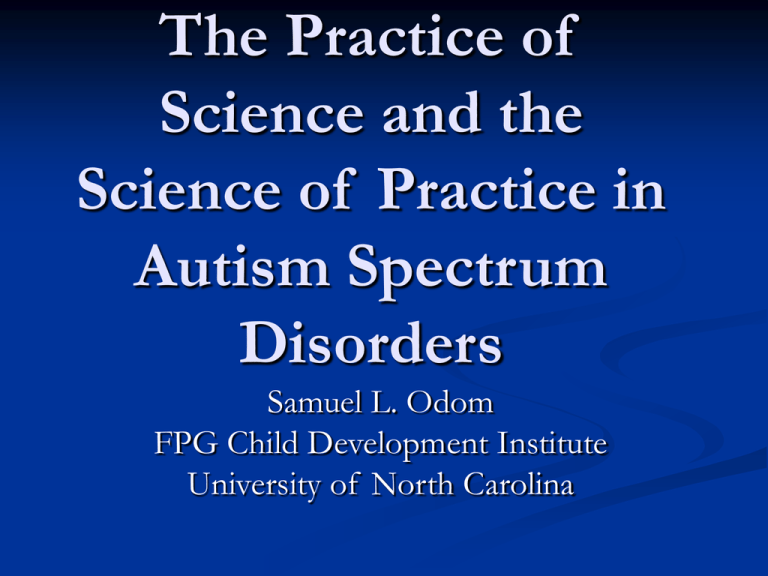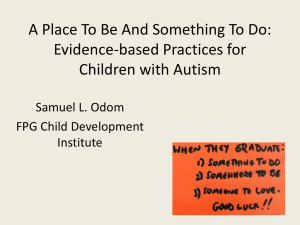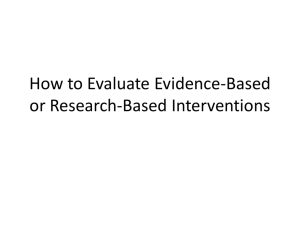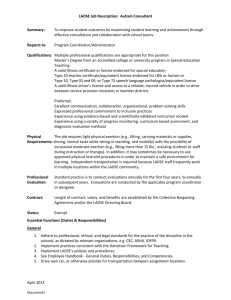Evidence-based Treatment in Autism: Single
advertisement

The Practice of Science and the Science of Practice in Autism Spectrum Disorders Samuel L. Odom FPG Child Development Institute University of North Carolina Goals of the Presentation Describe the origins of evidence-based practice Examine process and criteria for identifying evidence-based practice in behavioral intervention research Discuss issues related to implementation of EBPs Describe strategies for supporting implementation Animal Models for Intervention Neuroscience Autism and ASD: Agreeing on Terminology and Characteristics Definition and Diagnosis (Autistic Disorder) DSM-IV Criteria often the standard for diagnosis criteria Core features Social competence Communication Repetitive behavior/need for sameness Autism Spectrum Disorder Autistic Disorder Pervasive Developmental Disorder Not Otherwise Specified Asperger’s Disorder Practice of Science in Autism Intervention Research Goals have been: Cure autism Remediate or ameliorate condition for children and families Social science intervention research has focused on two classes of interventions in its research literature Comprehensive treatment models Focused intervention models What Do We Mean By Practice? Comprehensive Models vs. Focused Interventions Comprehensive models are multi-component programs designed to positively and systematically affect the lives of children with ASD and their families Focused interventions are procedures that promote individual skills or learning within a specific skill area. Origins of Evidence Based Practices Current emphasis may be traced to Cochrane’s (1972) concern about the lack of use of research in health care practice Formation of Cochrane Collaborative to conduct systematic reviews of effects of health care interventions Evidence-based medicine coined as a term at McMaster University in 1980’s Sackett and colleagues were primary early advocates for evidence-based medicine Sackett (1996) qualifications of EBM Neither old hat nor impossible to practice Not at “cook-book” medicine Not a cost cutting medicine Not restricted to randomized trials and meta-analyses Movement of “evidence-based” into Education Campbell Collaboration formed (in the US) in 1990 to conduct systematic reviews of educational and social policy practices What Works Clearinghouse funded by Institute of Education Sciences operates through CC Evidence for Policy and Practice Information Center (EPPIC) at the University of London Institute of Education was created in 1993 Center for Evidence-Based Practice at Orelena Puckett Institute in North Carolina Efforts to Identify Evidence-Based Practices/Professional Associations Child-Clinical Section of Division 12 of the American Psychological Association CEC-Division for Research National Association for School Psychology (empirically supported interventions) ASHA DEC Recommended Practices APA Task Force on Promotion and Dissemination of Psychological Procedures: Well Established At least two well-conducted group-design studies, conducted by different investigators Superior to pill placebo or alternative treatment Equivalent to well established treatment Large series of single-case design studies (n>9) that use good experimental design and compare the intervention to another treatment Treatment manuals used for the intervention Clearly specify sample characteristics Attempts to Examine EvidenceBased Practices for Children with Autism Spectrum Disorder States Research Organizations National Academy of Sciences National Autism Center—National Standards Project Professional Organizations New York Department of Health California Department of Human Resources National Academy of Pediatrics Scholars Rogers Dawson & Osterling Odom, Brown, et al. (2003) What Counts As Evidence? What Counts As Evidence? Peer-reviewed, refereed journal articles Report research Clearly identified children with ASD and/or families were participants Methodologies Experimental Group Designs Quasi experimental designs Single subject designs Quality Indicators for Experimental and Quasi-Experimental Research Gersten, Compton, Fuchs, Greenwood, Innocenti, & Coyne (2005) What do we mean by Experimental Group Research? Randomized Clinical Trials (Randomized Experimental Group Designs) Quasi-Experimental Designs Quality Indicators for Single Subject Design Horner, Carr, Halle, McGee, Odom, & Wolery (2005) Major Quality Indicator Categories Experimental Control Description of participants and setting Dependent variable Independent variable Baseline External Validity Social Validity Criteria for Evidence-Based Practices for Focused Interventions (NPDC-ASD) Two high quality randomized experimental group design or quasi-experimental group designs that rule out selectivity and other threats to internal validity Five high quality single subject design At least three different researchers in different locations Each study has at least three demonstrations of experimental control Criteria for Evidence-Based Practices for Focused Interventions (NPDC-ASD) Combined evidence One RCT or high quality quasiexperimental design At least three high quality single subject designs Review of Literature Began by looking at outcomes that related to the core features of autism Social Communication Repetitive and problem behavior Adaptive behavior Academic skills Identified and grouped interventions that addressed these skills Looked for similar interventions across skill domains and age levels Focused-Interventions Identified Behavioral intervention practices Prompting Time delay Reinforcement Task Analysis and Chaining Behavioral Interventions to Decrease Interfering Behaviors Positive behavior support Functional Behavior Assessment Differential reinforcement of alternative behavior Extinction Response interruption/redirection Stimulus Control Functional Communication Training Focused Interventions Discrete trial training Naturalistic intervention Pivotal response training Self-management Focused Interventions Visual supports Individualized work systems Video modeling Computer-assisted instruction VOCA Focused Interventions Social skills training Peer mediated intervention Social Stories Picture exchange communication system (PECS) Evaluation of Comprehensive Treatment Models for Individuals with ASD Odom, Boyd, Hall, & Hume (2009) Evaluation Purpose Provide information upon which to make decisions School districts to make decisions about adoption Families choose a model for their children Systematic review of “model features” Critical evaluation Comprehensive Treatment Strategies Multiple components (e.g., child-focused instruction, family-focused support) Broad scope (i.e., they address development domains representing the core features of ASD) Intensity (i.e., they often occur over an entire instructional day or in multiple settings such as a school/clinic and home) Longevity (i.e., they may occur over months or even years). Replication in the US Evaluation of all CTMs Located all articles in publicly available locations (e.g., journals, book chapters, computer searches, public presentations, etc.) Searched websites for information Interviewed every CTM developer CTM developers send additional materials for our review Some not publicly available Evaluation of six features of the programs Operationalization Fidelity of Implementation Replication Outcomes reported Quality of the research methodology Supplemental research on focused intervention features of the CTM Review by Two Evaluators All trained on two CTMs, up to an 80% criteria Primary evaluator constructed the portfolio and completed evaluation Secondary evaluator completed second review of each portfolio When disagreements occurred, resolved through discussion Inter-rater agreement was 83% (exact agreement) The Green CTMs Denver Model LEAP Lovaas Institute May Institute Princeton Child Development Institute Emerging Evidence Autism Partnerships CARD Children’s Toddler Program Douglass Developmental Center Pivotal Response Treatment (PRT) Responsive Teaching SCERTS STAR TEACCH Conclusions Strongest feature of CTM literature is operationalization Fidelity documented but not in rigorous manner Efficacy and effectiveness studies are limited but growing Difficulty for classroom-based models Generational issues Models are evolving








